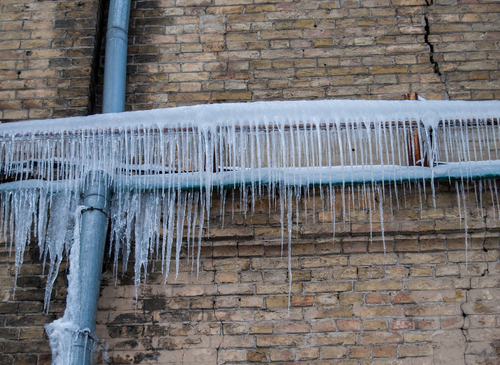We've encountered this article relating to Winter Plumbing Precautions: Preventing Frozen Pipes down the page on the internet and decided it made good sense to share it with you on this site.

Winter can wreak havoc on your plumbing, especially by freezing pipelines. Below's how to avoid it from occurring and what to do if it does.
Intro
As temperature levels decrease, the risk of frozen pipelines boosts, potentially leading to costly fixings and water damage. Comprehending how to avoid icy pipes is critical for home owners in cold environments.
Avoidance Tips
Insulating prone pipelines
Wrap pipelines in insulation sleeves or use heat tape to secure them from freezing temperature levels. Focus on pipelines in unheated or external locations of the home.
Home heating techniques
Keep indoor spaces sufficiently heated, especially areas with plumbing. Open cabinet doors to enable cozy air to distribute around pipelines under sinks.
Exactly how to determine frozen pipes
Seek lowered water circulation from faucets, unusual odors or sounds from pipelines, and noticeable frost on subjected pipes.
Long-Term Solutions
Architectural adjustments
Take into consideration rerouting pipelines away from outside walls or unheated locations. Include added insulation to attic rooms, cellars, and crawl spaces.
Upgrading insulation
Purchase high-quality insulation for pipes, attic rooms, and wall surfaces. Proper insulation helps preserve constant temperature levels and lowers the threat of icy pipelines.
Protecting Outdoor Pipes
Garden pipes and exterior faucets
Detach and drain pipes garden tubes prior to winter months. Mount frost-proof faucets or cover outside faucets with protected caps.
Comprehending Frozen Pipes
What creates pipelines to freeze?
Pipes freeze when revealed to temperature levels below 32 ° F (0 ° C) for extended durations. As water inside the pipes freezes, it expands, taxing the pipe walls and possibly causing them to burst.
Threats and damages
Icy pipes can lead to water disturbances, building damage, and pricey repair work. Ruptured pipes can flooding homes and trigger considerable structural damages.
Indicators of Frozen Pipeline
Recognizing icy pipes early can avoid them from rupturing.
What to Do If Your Pipelines Freeze
Immediate actions to take
If you think icy pipelines, maintain faucets available to soothe pressure as the ice melts. Utilize a hairdryer or towels soaked in warm water to thaw pipelines gradually.
Verdict
Preventing frozen pipes requires proactive actions and fast responses. By understanding the causes, indicators, and preventive measures, house owners can shield their pipes throughout cold weather.
6 Proven Ways to Prevent Frozen Pipes and Protect Your Home
Disconnect and Drain Garden Hoses
Before winter arrives, start by disconnecting your garden hoses and draining any remaining water. Close the shut-off valves that supply outdoor hose bibs and leave the outdoor faucet open to allow any residual water to drain. For extra protection, consider using faucet covers throughout the colder months. It’s also important to drain water from any sprinkler supply lines following the manufacturer’s directions.
Insulate Exposed Pipes
Insulating your pipes is an effective way to prevent freezing. Pipe insulation is readily available at home improvement stores and is relatively inexpensive. Pay close attention to pipes in unheated areas such as the attic, basement, crawl spaces, or garage. Apply foam insulation generously to create a buffer against the cold. You can also wrap your pipes in heat tape or thermostat-controlled heat cables for added warmth.
Seal Air Leaks
Inspect your home for any cracks or openings that could let in cold air. Seal any holes around the piping in interior or exterior walls, as well as the sill plates where your home rests on its foundation. Additionally, make sure to keep your garage door closed unless you’re entering or exiting. Leaving it open creates a significant air leak that can lead to frozen pipes.
Allow Warm Air Circulation
During cold snaps, it’s essential to allow warm air to circulate evenly throughout your home. Leave interior doors ajar to promote better airflow. Open kitchen and bathroom cabinets to help distribute heat consistently around the rooms. If you have small children or pets, be sure to remove any household chemicals or potentially harmful cleaners from open cabinets for safety.
Let Faucets Drip
A small trickle of water can make a big difference in preventing ice formation inside your pipes. When temperatures drop significantly, start a drip of water from all faucets served by exposed pipes. This continuous flow helps prevent the water from freezing. Additionally, running a few faucets slightly can relieve pressure inside the pipes, reducing the chances of a rupture if the water inside does freeze.
https://choateshvac.com/6-proven-ways-to-prevent-frozen-pipes-and-protect-your-home/

We had been shown that write-up about Preventing and dealing with frozen pipes from a good friend on a different site. Sharing is caring. One never knows, you may very well be helping someone out. Thanks a lot for your time. Kindly visit our site back soon.
Website
Comments on “Avoiding Frozen Pipes in Cold Weather: Expert Strategies”